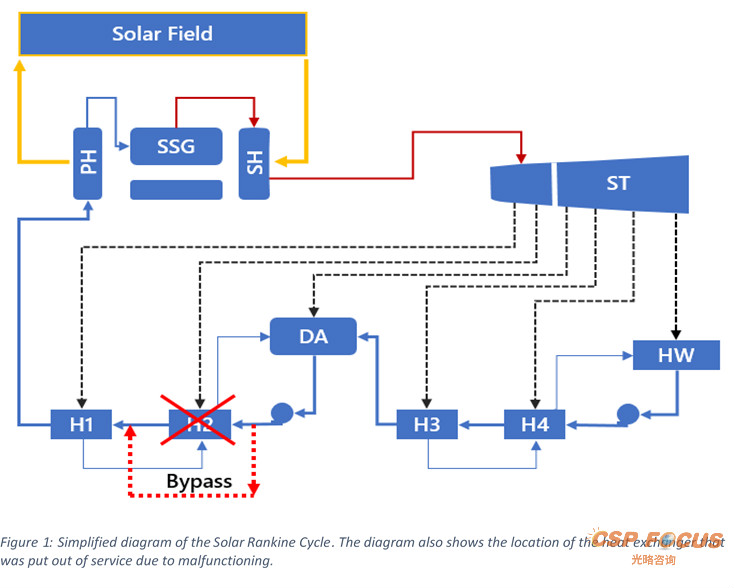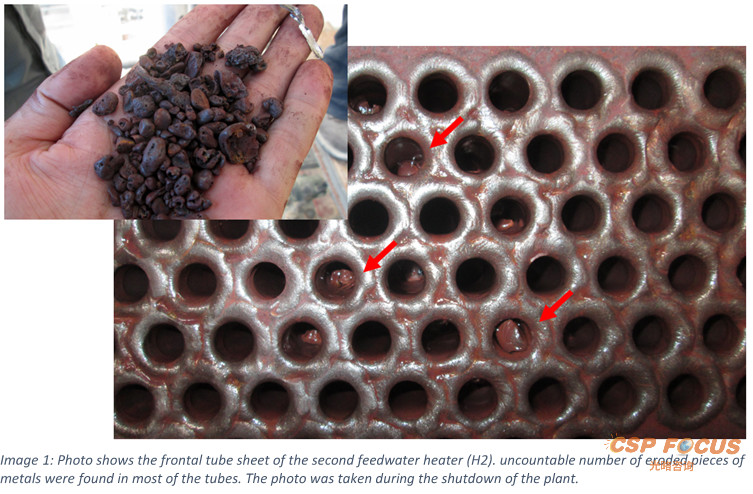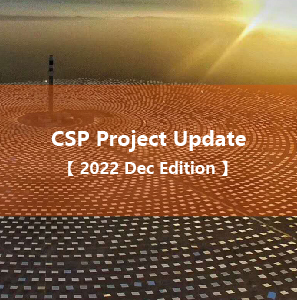Home > Market > Other Regions > Here
How Failures During Commissioning Can Affect the Performance of a CSP Solar Power Plant
2020.04.23 From: Andres Rodriguez Perez
Abstract
Failures in the execution of commissioning activities, like chemical cleaning or steam blowing, can go unseen for the first several months of operation, but they have the potential cause a direct impact in the performance of a power plant.
This article presents the problems experienced in a CSP Solar Power Plant, due to damages in the regeneration system, and how they dragged down the productivity of the plant.
Performance & Regeneration
Solar power plants operate on the principles of fluid mechanic and thermodynamic. The core value of any system design is the mass & heat balance, which subsequently stands as the building blocks of the performance model.
The performance model is conceived to identify the most significant aspects of the way in which a solar plant operates under ideal conditions. The results are used as a reference for running the plant as close as possible to that theoretical model. Along this line, we can identify divergencies, understand the way a solar plant functions and enhance the overall efficiency of the plant.
The overall efficiency depends on the performance of each individual system, and in this regard, regeneration plays an important role. The idea behind regeneration is to increase the thermal efficiency of the plant by raising the feedwater temperature before it enters the Solar Steam Generator (SSG). The process is accomplished in the so-called feedwater heaters where water is heated with bleed steam extracted from different stages of the turbine at given thermal conditions.
Regeneration decreases the thermal input required, reduces the gradient of enthalpy in the SSG, minimizes the risk of thermal shock in the preheater and increases the overall efficiency. Therefore, any possible departure from the expected operation of the regeneration system, will directly drag down the productivity of the plant.
That was the case experienced in a CCP solar power plant due to severe failure in the feedwater heaters.
Description of the Process
The design of the plant incorporates parabolic through technology to capture solar energy in a heat transfer fluid (HTF). The HTF is sent to the solar steam generator (SSG) to exchange its enthalpy with high quality water to produce superheated steam. The process is carried out in a counter-current flow scheme, so hot oil produces superheated steam, then boils the water in the evaporators and finally, preheats the water in the economizer unit. The efficiency of the heat transfer depends on the water inlet temperature at this point of the system.
Eventually, the superheated steam is admitted to a steam turbine which exhausts the load to a surface condenser. The hotwell section serves as a water reservoir from where the condensate is pumped back to the cycle.

Now is when Regeneration takes place. A battery of heat exchangers set in a cascade configuration, are employed to rise the temperature of the water up to the steam generator economizer inlet. As depicted in figure 1, H3 and H4 are low pressure heat exchangers whereas H1 and H2 are designed for high-pressure. All of them are shell-tube type. Water flows through the tube side of the unit, while bleed steam is condensing in the shell side (black dash line). DA represents the deaerator, which is a direct mixing exchanger designed for removal of oxygen, CO2 and volatile impurities.
Failures in the Regeneration System
Operating anomalies were observed in the functionality of the feedwater heaters H1 and H2 throughout the first months of operation. A gradual decrease in their thermal performance brought the appearance of collateral problems which ended up affecting the total efficiency of the cycle. Therefore, a failure investigation was conducted to find out the root-cause of the problem and implement corrective actions to improve its performance.
The results of the analysis determined that these heaters got affected during the commissioning of the project. Both units were included in the scope of chemical cleaning and initial flushing, though, poor actions were taken to preserve their integrity during the execution of the activities. As a result, the second heater H2 acted as a real filter and a great deal of metal debris got blocked in most of the tubes. In view of the severe damage and leakages, this unit had to be replaced one year later.
Image 1 shows the frontal tube sheet of the second feedwater heater (H2). There were found uncountable numbers of eroded fragments of metals, welding slags, and stones embedded in the tubes. More than 55% of the tube bundle got permanently clogged.

The problem was detected due to a significant overconsumption in the feedwater pumps. Friction losses through the heaters may cause restriction of the water flow, and pumps need to increase speed to overcome the pressure drop. This could bring pumps to run beyond the allowable operating range which intensely reduces their efficiency. In a more extreme scenario, if the situation persists, the temperature reached in the pump could bring the water to its boiling point and cause more serious problems like cavitation, vibrations or mechanical failures in the rotating components.
The presence of metal debris in the heaters and the material incompatibility with the tubes favored the appearance of several types of corrosion attack. Subsequently, some them started to leak. Since pressure in the water side is around 80-100 bars greater than in the steam side, the mass of water passing to the shell side was enough to reduce the temperature of steam several degrees. This made the heat transfer not only less effective but also reduced the pressure in the deaerator. As a consequence, the quality of the water may be affected.
In any case, all of these instabilities forced opening the H2 manual bypass and leaving the heater out of service.
Bypassing H2 implied a temperature drop of 25ºC on average at the preheater inlet. The loss of enthalpy can be compensated by putting in solar tracking additional CCP mirrors. This action will concentrate more energy and increase the flow of HTF.
However, the problem went unseen for the first months of operation because, as it pertains to the process design, heaters H1 and H2 would remain out of service or in intermittent operation during summer operating mode. Thus, the 1st and 2nd extractions would be closed for the turbine to gain an extra flow of steam, and so, increase the production in 5% of the nominal gross. During winter, the maximum yield of the plant is achieved by using the total solar field, therefore, there would not be additional availability of solar field to mitigate the fall of temperature in the water side. So, the plant was forced to accept a loss of efficiency.


The problem in the feedwater heaters brought one further issue which also affected the performance of the plant which is depicted in Figure 3. Since the preheater inlet temperature is lower, and there is not extra heat input from the turbine extractions, the SSG would take longer to achieve its operating nominal point during the daily startup. By the same token, there was a loss of intertia on daily shutdown.
Conclusions
Commissioning is likely the most critical stage in the life time of a power plant due to the transient conditions which systems and equipment are exposed to. The total efficiency of the plant depends on the functionality of all of them.
Thus, any failure in design and execution of field activities have the potential to damage critical equipment and cause deviations in their expected performance. This may represent a significant impact in the overall performance of the plant. Therefore, it is advised to carry out continuous inspections, comprehensive monitoring of each system during the start-up of the plant, especially, develop Hazard and Operability Analysis plan for critical commissioning activities.
Click to contact Andres Rodriguez Perez
Upcoming CSP events:
10th CSP Focus China 2020 (May 20-21, Beijing China)
5th CSP Focus MENA 2020(June.23-24,Dubai, UAE)
More CSP news and reports please visit www.cspfocus.cn
or CSP Focus social media on LinkedIn, Twitter, Facebook.
More from CSP Focus
NextSaudi Arabian hybrid solar-gas plants produce world cheapest CSP
CSP-PV solar project Noor Midelt I: EDF Renewables consortium wins
Experts: Most Efficient Solar to Split Water to Hydrogen is CSP
SolarReserve nixes Nevada plans for world’s largest solar project
Saudi Arabia Looks to China for Solar as Power Politics Shift
Aalborg CSP acquires unique Pit Thermal Energy Storage (PTES) technology
Researchers develop new method to remove dust on solar panels
Protermosolar: Concentrated Solar Power exceeds 5 TWh in 2019 in Spain
Leave your thoughts here
Reports(Member Only)
See more+-
CSP Focus Membership Proposals
We are now proposing CSP Focus Membership, hoping to better serve our members to keep pace with the latest updates of ongoing CSP projects worldwide, and to establish and maintain business relations with major shareholders of the projects. CSP Focus offers to Membership exclusive access to:1. Daily/Weekly update and analysis on CSP policies, projects, technologies, market trend and corporate relea
-
The Latest CSP Focus Monthly Update
Join CSP Focus Membership to Get the Latest CSP Focus Monthly Update December Edition.
-
CSP Project Monthly Update 2022 December Edition
CSP Focus is presenting CSP Project (China) Update 2022 December Edition.Detail report is available for CSP Focus Membership.
-
Presentations-CSP Focus China 2021
The Report is for CSP Focus Members only.
Upcoming Events
See more+-
12th CSP Focus China 2022
2022.04.21-22 Beijing
-
11th CSP Focus China 2021
2021.10.28-29 Beijing
-
10th CSP Focus China 2020
2020.10.22-23 Beijing, China
Project Updates
See more+-
Lanzhou Dacheng Dunhuang CSP Project
Asia Pacific-China,Operational,Parabolic Trough
-
Luneng Haixi 50MW Molten Salt Tower CSP Project
Asia Pacific-China,Operational,Power Tower
-
Dubai 950MW NOOR Energy 1 CSP+PV Project
MENA-UAE,Under construction,Power Tower
-
Power China Gonghe 50MW Molten Salt Tower CSP Project
Asia Pacific-China,Operational,Power Tower





